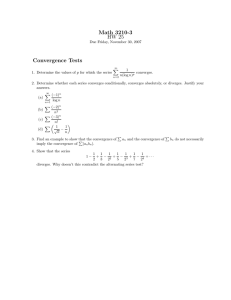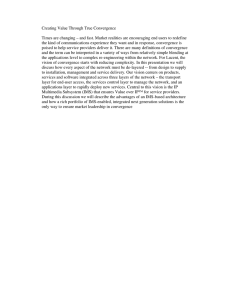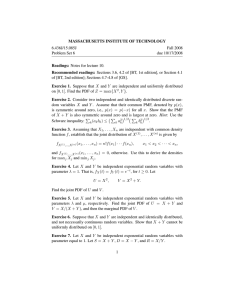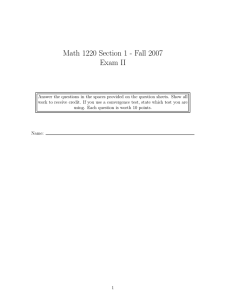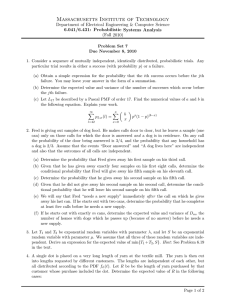LECTURE 9 Last time: Channel capacity
advertisement
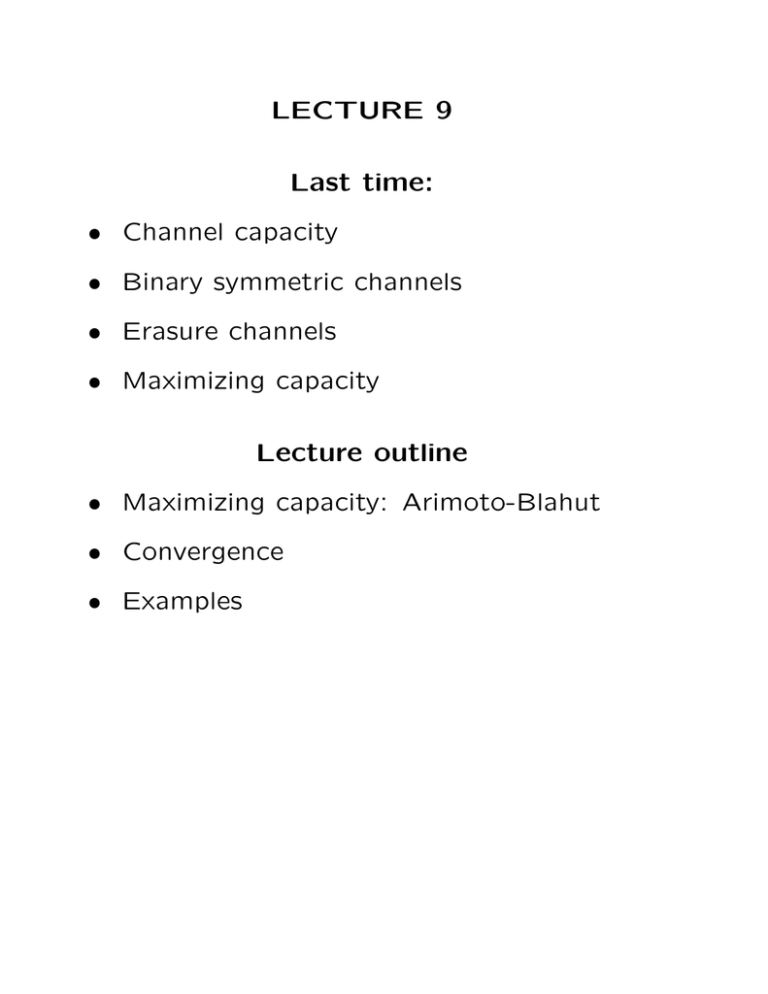
LECTURE 9
Last time:
• Channel capacity
• Binary symmetric channels
• Erasure channels
• Maximizing capacity
Lecture outline
• Maximizing capacity: Arimoto-Blahut
• Convergence
• Examples
Arimoto-Blahut
Lemma 1:
I(X; Y ) = max
� �
PX (x)PY |X (y |x)
P�X|Y y∈Y x∈X
⎛
⎞
�
P
(x|y)
⎝ X |Y
⎠
log
PX (x)
Proof:
I(X; Y ) =
�
�
�
x∈X
x∈Y
PX|Y (x|y)PY (y) log
Recall:
PX|Y (x|y) = �
PX (x)PY |X (y|x)
x� ∈X PX (x� )PY |X (y|x� )
and
PY (y) =
�
�
�
x�∈X PX (x )PY |X (y|x )
PX|Y (x|y)
PX (x)
�
Arimoto-Blahut
I(X; Y ) −
⎛
PX (x)PY |X (y |x)
y∈Y x∈X
⎞
P�X |Y (x|
y)
log
⎝
PX (x)
=
I(X; Y ) −
⎛
� �
� �
PY (y)PX |
Y (x|y)
y∈Y x∈X
⎞
P�X |Y (x|
y)
log
⎝
⎠
PX (x)
⎠
⎛
⎞
PX |Y (x|y)
⎝
⎠
=
PY (y)PX |
Y (x|y) log �
PX |
Y (x|
y)
y∈Y x∈X
(using log(x) ≥ 1 −
1
x
)
� �
�
�
≥
−
PY (y)PX |
Y (x|y)
y ∈Y x∈X
� �
y∈Y x∈X
=
0
PY (y)P�X |
Y (x|y)
Arimoto-Blahut
Capacity is
C = max max
� �
PX P�
X|Y y∈Y x∈X
⎛
⎞
�
PX |Y (x|y)
⎝
⎠
log
PX (x)
PX (x)PY |X (y |x)
For fixed PX , RHS is maximized when
P�X |Y (x|y) = �
PX (x)PY |X (y|x)
�
�
x� ∈X PX (x )PY |X (y|x )
For fixed P�X|Y , RHS is maximized when
�
PX (x) =
e
�
x�∈X
y∈Y
� �
e
PY |X (y |x) log(P�X |Y (x|y))
�
�
�
y∈Y PY |X (y|x ) log(PX|Y (x |y))
�
Arimoto-Blahut
Combining the two means maximization when
�
�X |Y (x|y))
P (y|x) log(P
e y∈Y Y |X
� �
�
PX (x) =
�
�
�
�
PY |X (y|x ) log(PX|Y (x |y))
y∈Y
x� ∈X e
�
�
�
PY |X (y|x)
PY |X (y |x) log �
y∈Y
PX (x� )PY |X (y |x� )
x� ∈X
PX (x)e
⎛
=
�
�⎞
�
PY |X (y|x)
PY |X (y |x� ) log �
⎜
⎟
y∈Y
�
PX (x� )PY |X (y |x� )
�
⎜
⎟
x� ∈X
x� ∈X PX (x ) ⎝e
⎠
Note also that
�
x∈X PX (x) = 1.
This may be very hard to solve.
Arimoto-Blahut
Proof:
The first two statements follow immedi­
ately from our lemma
For any value of x where PX |Y (x|y) = 0,
PX (x) should be set to 0 to obtain the max­
imum.
To find the maximum over the PMF PX ,
let us first ignore the constraint of positiv­
ity and use a Lagrange multiplier for the
�
x PX (x) = 1
Then
∂
�
�
{ x∈X y∈Y PX (x)PY |X (y|x) log
∂PX (x)
�
λ ( x∈X PX (x) − 1)} = 0
�
�
�
PX |Y (x|y)
+
PX (x)
Arimoto-Blahut
Equivalently
�
�
�
− log(PX (x))−1+ y∈Y PY |X (y|x) log P�X|Y (x|y) +
λ=0
so
�
PX (x) =
e
�
x∈X
�
�
x∈X PY |X (y|x) log PX|Y (x|y)
�
e
�
�
�
x∈X PY |X (y |x) log PX |Y (x|y)
�
(this ensures that λ is such that the sum
of the PX (x)s is 1)
What about the constraint we did not use
for positivity?
The solution we found satisfies that.
Convergence of Arimoto-Blahut
0 be a PMF and let
Let PX
r+1
r (x)
PX
(x) = PX
�
�
�
�
�
r (x ),...,P r (x
cx PX
1
X |X | )
r
r
x� ∈X cx PX (x1 ),...,PX (x|X | )
r (x� )
PX
where
�
�
r
r
cx PX (x1), . . . , PX (x|X |)
�
=e
y∈Y
�
PY |X (y|x) log
PY |X (y |x)
�
�
�
x� ∈X PX (x )PY |X (y|x )
�
the sequence I r of I(X; Y ) for X taking the
R for I r converges to C from below
PMF PX
Convergence of Arimoto-Blahut
Proof:
r , we can increase mutual
For any given PX
information by taking
PYr |X
r (x)P
PX
Y |X (y |x)
r
�
�
x� ∈X PX (x )PY |X (y|x )
=�
r+1
With PYr |X fixed, then choose PX
by
r+1
PX
(x) = �
�
r
y∈Y PY |X (y |x) log(PX |Y (x|y))
e �
x� ∈X
e
r
�
�
y∈Y PY |X (y |x ) log(PX |Y (x |
y))
If we define
Jr
=
�
�
x∈X
�
r+1
P
y∈Y X (x)PY |X (y|x) log
r (x|y )
PX
|Y
r+1
PX
(x)
Then I r ≤ J r ≤ I r+1 ≤ J r+1 ≤ . . .
This an upper bounded non-decreasing se­
quence, therefore it reaches a limit
�
Convergence of Arimoto-Blahut
Why is the limit C?
∗ be a capacity achieving PMF
Let PX
⎛
=
=
−
⎞
r+1
�
PX (x)
∗
⎝
⎠
PX (x) log
r
PX (x)
x∈X
�
∗ (x)
PX
x∈X
�
�
⎛
⎞
r
r
cx PX (x1), ..., PX (x|X |)
⎝
⎠
�
�
log
�
r
r
r
�
x
� ∈X cx
PX (x1 ), ..., PX (x|X |
) PX (x )
�
�
∗
PX (x)
PY |
X (y|x)
x∈X
y∈Y
⎛
⎞
PY |X (y |x)
⎝
⎠
log
�
r
�
�
x� ∈X PX (x )PY |
X (y |x )
�
�
∗
PX (x)
PY |
X (y |x)
x∈X
y∈Y
⎛
�
r (x�
)
⎝
log
PX
x�∈X
�
�⎞
PY |X (y � |x� )
�
� �
�
r
⎟
y
� ∈Y PY |X (y |x ) log
�� ∈X
PX (x�� )PY |
X (y � |x�� )
⎟
x
e
⎠
Convergence of Arimoto-Blahut
By considering the K-L distance, we have
that
�
�
∗
x∈X y∈Y PX (x)PY |X (y |x)
��
∗ (x� )P
� ) �
P
(y
|
x
�
log �x ∈X PXr (x�)PY |X (y
|x
�
)
≥ 0
Y
|
X
x�
∈X
X
so
≥
−
⎛
⎞
r
+1
�
∗ (x) log
⎝ PX (x)
⎠
PX
r (x)
P
X
x∈X
�
�
∗ (x)
PX
PY |
X (y|x)
x∈X
y∈Y
⎛
⎞
PY |X (y |x)
⎝
⎠
log
�
∗
�
�
x�∈X PX (x )PY |
X (y |x )
�
�
∗
PX (x)
PY |
X (y |x)
x∈X
y∈Y
⎛
�
r (x�
)
log
⎝
PX
x�∈X
�
PY |X (y � |x� )
�
� �
�
r ��
y
� ∈Y PY |X (y |x ) log
e
�⎞
� ��
x�� ∈X
PX (x )PY |
X (y |x )
⎟
⎟
⎠
Convergence of Arimoto-Blahut
Hence
⎛
≥
⎞
r+1
�
PX (x)
∗
⎝
⎠
PX (x) log
r
PX (x)
x∈X
C − Jr
Sum over r
m
�
≤
=
≤
(C − J r )
r=0
m �
�
⎛
⎞
r+1
∗ (x) log
⎝
PX (x) ⎠
PX
r (x)
P
X
r=0
x∈X
⎛
⎞
m+1
�
PX
(x)
∗
⎝
⎠
PX (x) log
0
PX (x)
x∈X
�
�
∗
�
∗ (x) log PX (x)
PX
0 (x)
PX
x∈X
C−J r ≥ 0 and non increasing, with bounded
sum, so it goes to 0, hence J r converges
to C
convergence can be
very slow
In practice,
Example
Other types of maximization
Interior point methods
Cutting plane algorithms
MIT OpenCourseWare
http://ocw.mit.edu
6.441 Information Theory
Spring 2010
For information about citing these materials or our Terms of Use, visit: http://ocw.mit.edu/terms.

